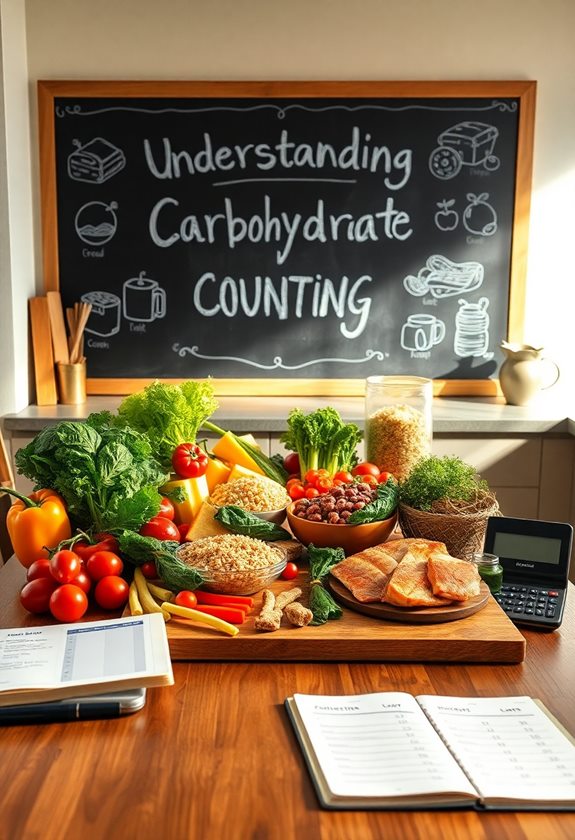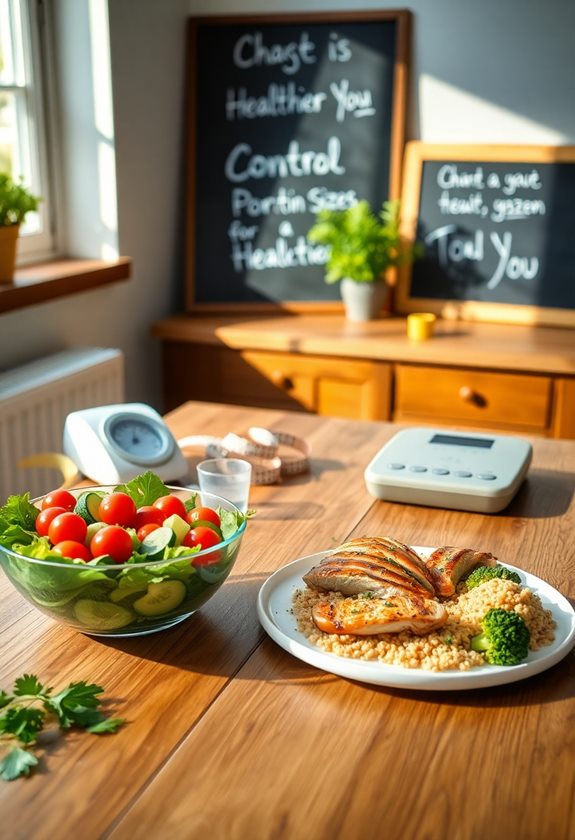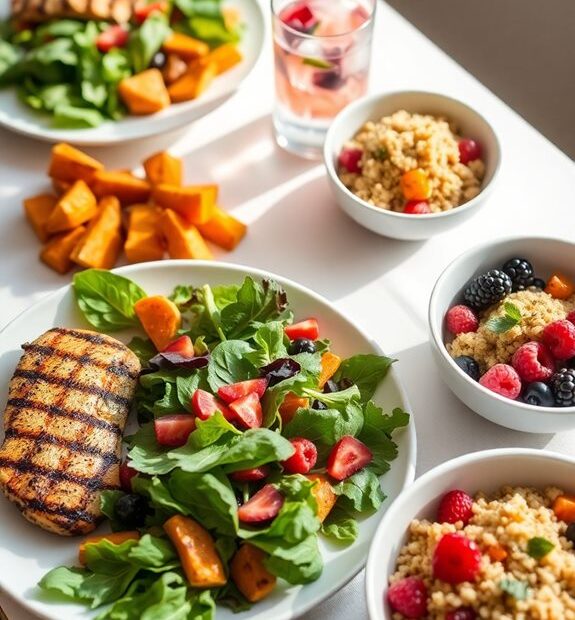You can make managing diabetes and losing weight easier with these 10 tips! First, focus on carbohydrate counting; aim for 45-60 grams per meal. Next, enjoy lean proteins like chicken and fish, and don't forget about healthy fats such as avocados and nuts. Make whole grains your go-to—try oatmeal or quinoa! Remember to load up on colorful vegetables; they're low in calories but high in nutrients. Control your portions, stay hydrated with water, and limit added sugars. Keep an eye on your blood sugar levels, and you'll be well on your way. Curious to know more?
Key Takeaways
- Focus on whole foods by choosing vegetables, whole grains, and lean proteins to enhance nutrition and manage blood sugar levels effectively.
- Control portion sizes using smaller plates and measuring tools to prevent overeating and support weight loss goals.
- Stay hydrated by drinking at least 8 cups of water daily, as it helps control hunger and supports overall health.
- Monitor blood sugar levels regularly to understand how food choices impact your body and make necessary adjustments to meal plans.
- Incorporate healthy fats from sources like avocados and nuts to promote fullness and stabilize blood sugar levels throughout the day.
Understand Carbohydrate Counting

Understanding carbohydrate counting is essential for managing diabetes while pursuing weight loss. Carbs can impact your blood sugar levels, so knowing how to count them helps you make better food choices. Have you ever felt confused about which foods to eat? By learning to read food labels, you can spot carbs easily.
Start by keeping track of how many carbs you consume each meal. A handy rule is to aim for about 45-60 grams of carbs per meal. How can you figure out what's right for you? It often depends on your personal health goals and activity level.
When cooking, consider using whole foods like vegetables, fruits, and whole grains. These options usually contain more fiber and nutrients compared to processed foods. For instance, instead of white bread, try whole-grain bread. Not only does it taste good, but it also keeps you fuller longer.
Focus on Lean Proteins
When managing diabetes and aiming for weight loss, incorporating lean proteins into your meals can make a significant difference. Lean proteins, like chicken breast, fish, and legumes, help you feel full without adding too many calories. Have you ever noticed how a hearty meal keeps you satisfied longer? That's the power of protein!
Including lean proteins in your diet can stabilize your blood sugar levels. When you eat protein, it slows down digestion and helps prevent sharp spikes in your blood sugar. Think about it: wouldn't you rather enjoy a grilled turkey burger than a greasy fast-food option?
You might wonder how to add more lean proteins to your meals. Consider starting your day with eggs or Greek yogurt. For lunch, opt for a salad topped with grilled chicken or chickpeas. Dinner can be as simple as baked fish with steamed veggies.
Incorporate Healthy Fats

Incorporating healthy fats into your diet can be a game-changer for managing diabetes and supporting weight loss. But what exactly are healthy fats? You might be surprised to learn that fats from sources like avocados, nuts, seeds, and olive oil can actually help you feel full and satisfied. Isn't that a relief?
When you include these fats in your meals, you slow down digestion, which can help keep your blood sugar levels steady. For example, try adding a handful of almonds to your morning oatmeal or drizzling olive oil on your salad. These simple swaps can make a big difference!
Now, you might be wondering how to fit healthy fats into your meal plan. Start small! You don't need to overhaul your entire diet overnight. Just replace some of your usual cooking oils with healthier options or choose fatty fish like salmon a couple of times a week.
Choose Whole Grains
Choosing whole grains is essential for anyone looking to manage diabetes and support weight loss effectively. Whole grains, like brown rice, quinoa, and whole wheat bread, are packed with fiber. Why is fiber important? It helps you feel full longer and keeps your blood sugar steady.
When you replace white bread or rice with whole grain options, you're making a smart choice. Have you ever noticed how a slice of whole grain bread keeps you satisfied compared to white bread? That's the power of whole grains!
You might wonder how to include them in your meals. Start your day with oatmeal or whole grain cereal. For lunch, try a quinoa salad or a wrap made with whole grain tortillas. Even dinner can be more filling with brown rice or whole wheat pasta.
Load Up on Vegetables

Loading up on vegetables is a fantastic way to enhance your meals while keeping calorie counts low. They're packed with vitamins, minerals, and fiber, which can help you feel full longer. Plus, they add color and flavor to your plate! Have you ever thought about how easy it is to sneak in more veggies during the day?
Here are some fun ideas to get you started:
- Mix into meals: Toss spinach or zucchini into pasta dishes or soups.
- Snack smart: Munch on baby carrots, bell peppers, or cherry tomatoes with a healthy dip.
- Try new veggies: Experiment with different types, like kale, asparagus, or eggplant, to keep things interesting.
Plan Balanced Meals
Creating balanced meals is essential for managing blood sugar levels while supporting weight loss. You might wonder, what does a balanced meal look like? It's all about combining the right foods. Start with lean proteins like chicken or tofu, which help keep you full. Add whole grains like brown rice or quinoa for energy. Don't forget to fill half your plate with colorful vegetables; they're packed with nutrients and fiber!
Have you tried using the "plate method"? This simple way of planning meals can really help. Picture your plate divided into sections: one-quarter for protein, one-quarter for whole grains, and half for veggies. It's a great visual tool that makes meal prep easier!
Also, consider incorporating healthy fats, like avocado or nuts. They add flavor and can keep you satisfied longer. Remember, it's not just about what you eat but how it makes you feel. When you enjoy your meals, it's easier to stick to your plan.
Control Portion Sizes

Controlling portion sizes is essential when managing diabetes and aiming for weight loss. It helps you enjoy your favorite foods while keeping blood sugar levels stable. Are you unsure how to get started? Here are a few tips to assist you:
- Use smaller plates: This simple trick can make your portions look larger, tricking your brain into feeling satisfied.
- Measure your food: Grab a kitchen scale or measuring cups to guarantee you're eating the right amounts. This can be eye-opening!
- Listen to your body: Eat slowly and pay attention to your hunger cues. Are you really still hungry, or are you just bored?
Stay Hydrated
Staying hydrated is crucial for everyone, but it's especially important for those managing diabetes and trying to lose weight. You've probably heard that water is essential, but do you know just how much it can help you? Keeping your body hydrated can help control hunger and boost your metabolism. It's a simple way to support your weight loss journey!
Here's a quick look at some benefits of staying hydrated:
| Benefit | How it Helps | Tip |
|---|---|---|
| Curbs Hunger | Feeling thirsty can mimic hunger. | Drink a glass of water before meals! |
| Boosts Energy | Dehydration can cause fatigue. | Keep a water bottle handy! |
| Supports Digestion | Water helps break down food. | Aim for at least 8 cups daily! |
| Improves Mood | Staying hydrated can boost your mood. | Add lemon or cucumber for flavor! |
Limit Added Sugars

Why is it essential to limit added sugars in your diet? Cutting back on added sugars can make a big difference in your health, especially if you're managing diabetes. Too much sugar can lead to weight gain and spikes in blood sugar levels. So, how can you keep your sugar intake in check?
- Choose whole foods: Fresh fruits, veggies, and whole grains are naturally low in sugar and packed with nutrients.
- Read labels: Always check food labels for added sugars. Look for terms like high fructose corn syrup or cane sugar.
- Limit sugary drinks: Sodas and sweetened beverages can add a lot of sugar without filling you up.
Monitor Blood Sugar Levels
Monitoring blood sugar levels is essential for anyone managing diabetes, as it helps you understand how different foods and activities affect your body. When you check your levels regularly, you can see how meals impact your glucose. Have you ever wondered why certain foods make you feel different?
For instance, if you eat a piece of fruit, monitor your blood sugar afterward. Did it rise more than you expected? This knowledge can guide your meal choices. It's all about finding what works for you.
Consider keeping a journal. Write down what you eat and your blood sugar readings. This can reveal patterns, making it easier to create meal plans that keep your levels stable.
Also, remember to check your levels before and after exercise. You might find that some activities lower your sugar, while others don't.
Lastly, don't hesitate to ask your healthcare team for advice. They can provide personalized tips that suit your lifestyle. Remember, you're not alone in this journey! 🌟 By staying informed and proactive, you're taking big steps toward better health.

